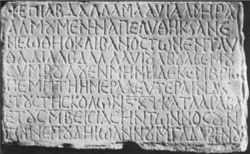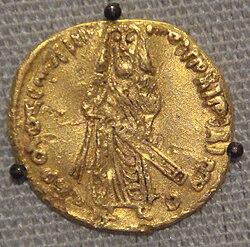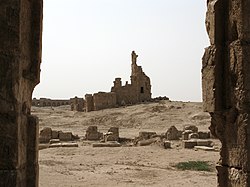Umayyad Caliphate
The Umayyad Caliphate (Arabic: الخلافة الأموية) also known as the Umayyad Empire, was the second of the four major Islamic caliphates established after the death of the Islamic prophet Muhammad. It was founded by Mu'awiya I, a companion of Muhammad. It was ruled by the Umayyad dynasty (Arabic: بنو أمية, Banu Umayyah), an Arab dynasty who came from Mecca, in present-day Saudi Arabia. Damascus was their capital from 661–744, Harran from 744–750, and after the Abbasid revolution, Córdoba (756–1031) in Al-Andalus, where they established the Emirate of Córdoba (756-929) and then the Caliphate of Córdoba (929-1031), also known as the Second Umayyad Caliphate.[2][3]
Umayyad Caliphate | |
|---|---|
| 661–750 | |
 The Umayyad Caliphate at its greatest extent, under Caliph Umar II, c. 720 | |
| Status | Empire |
| Capital | |
| Official languages | Arabic |
| Common languages | (official in certain regions until 700) various regional languages |
| Religion | Islam |
| Government | Hereditary caliphate |
| Caliph | |
• 661–680 | Mu'awiya I (first) |
• 744–750 | Marwan II (last) |
| History | |
• | 661 |
• | 750 |
| Area | |
| 720[1] | 11,100,000 km2 (4,300,000 sq mi) |
| Currency | |
By the mid 8th century AD, the territories of the Umayyad Caliphate spanned across three continents (Asia, Africa, and Europe). The Umayyad Caliphate was the largest empire in the world at the time. It is the fifth largest empire in history.[4] Some place the beginning of the Islamic Golden Age as early as the Umayyad Caliphate.[5][6]
Origins
According to tradition, the Umayyad family (also known as the Banu Abd-Shams) and the Islamic Prophet Muhammad both have a common ancestor, Abd Manaf ibn Qusai. Muhammad descended from Abd Munaf via his son Hashim, the Umayyads descended from Abd Munaf via a different son, Abd-Shams. The two families are therefore considered to be different clans (those of Hashim and of Umayya, respectively) of the same Arabian tribe (that of the Quraish).
The Umayyads and the Hashimites were bitter rivals. The rivalry came from the initial opposition of Abu Sufyan ibn Harb, the grandson of Umayya, to Muhammad and to Islam. He tried to get rid of the new religion by waging a series of battles. But eventually he accepted Islam, as did his son (the future caliph Muawiyah I[7]), and the two provided much-needed political and diplomatic skills for the management of the quickly expanding Islamic empire.

The origins of Umayyad rule date back to the assassination of Uthman in 656. At this time Ali, a member of the Hashim clan and a cousin of Prophet Muhammad, became the caliph. He soon met with resistance from several factions, including the Uthmaniyya, and moved his capital from Medina to Kufa. The resulting conflict, which lasted from 656 until 661, is known as the First Fitna ("time of trial").
Ali was first opposed by an alliance led by Aisha, the widow of Muhammad, and Talhah and Al-Zubayr, two of the Companions of the Prophet. The two sides clashed at the Battle of the Camel in 656, where Ali won a decisive victory.
When Ali was assassinated in 661, Muawiyah marched to Kufa. There he persuaded a number of Ali's supporters to accept him as caliph instead of Ali's son, Hasan. Then he moved the capital of the caliphate to Damascus. Syria would remain the base of Umayyad power until they established an emirate in Cordoba, which also became a world centre of science, medicine, philosophy and invention during the Islamic Golden Age.
Umayyad Caliphate Media
A Greek inscription crediting Mu'awiya for restoring Roman bathhouses at Hammat Gader near Tiberias in 663, the only known epigraphic attestation to Mu'awiya's rule in Syria
Arab-Sasanian-style Umayyad coin minted under Mu'awiya I rule in Basra in 675/76 in the name of the Umayyad governor Ubayd Allah ibn Ziyad. The latter's governorship later spanned all of the eastern caliphate. His father Ziyad ibn Abihi was adopted as a half-brother by Mu'awiya I, who made him his practical viceroy over the eastern caliphate.
Map of the caliphate during the Second Fitna in c. 686. The area shaded in red represents the approximate territory of the Umayyads, while the areas shaded in blue, green and yellow respectively represent the territories of the Mecca-based caliph Abd Allah ibn al-Zubayr, the pro-Alid ruler of Kufa Mukhtar al-Thaqafi, and the Kharijites
Abd al-Malik introduced an independent Islamic currency, the gold dinar, in 693, which originally depicted a human figure, likely the caliph, as shown in this coin minted in 695. In 697, the figural depictions were replaced solely by Qur'anic and other Islamic inscriptions
- The expansion of the Muslim Caliphate until 750, from William R. Shepherd's Historical Atlas. Muslim state at the death of Muhammad Expansion under the Rashidun Caliphate Expansion under the Umayyad Caliphate
A 14th-century illustration of the siege of Constantinople
The city of Resafa, site of Hisham's palace and court
Musicians and hunting cavalier, circa 730 CE. Floor fresco from Hisham's Qasr al-Hayr al-Gharbi, Syria. National Museum, Damascus.
Related pages
Notes
- ↑ Taagepera, Rein (September 1997). "Expansion and Contraction Patterns of Large Polities: Context for Russia". International Studies Quarterly. 41 (3): 496. doi:10.1111/0020-8833.00053. JSTOR 2600793. Archived from the original on 19 November 2018. Retrieved 22 August 2018.
- ↑ AL-Ajmi, Abdulhadi, The Umayyads, in Muhammad in history, thought, and culture: an encyclopedia of the Prophet of God. 2 vols, edited by C. Fitzpatrick and A. Walker. Santa Barbara, ABC-CLIO, 2014. ISBN 1610691776
- ↑ Bulliet, Richard W (2002). "The Second Umayyad Caliphate: The Articulation of Caliphal Legitimacy in al-Andalus (review)". Journal of Interdisciplinary History. 33 (2): 341–343. doi:10.1162/00221950260209156. S2CID 146340535. Template:Project MUSE.
- ↑ It is the third largest contiguous empire and the third largest empire by percentage of world population (33.5%)
- ↑ Rodríguez, Manuel Lozano (19 June 2023). Bioethics of Displacement and Its Implications. IGI Global. ISBN 9781668448090.
- ↑ Haberl, Ferdinand J. (22 March 2023). Jihadi Intelligence and Counterintelligence: Ideological Foundations and Operational Methods. Springer. ISBN 9783031247446.
- ↑ Most historians consider Caliph Muawiyah I (661-80) to have been the second ruler of the Umayyad dynasty, as he was the first to assert the Umayyads' right to rule on a dynastic principle. Caliph Uthman (644-56) was also descended from Umayya, and during his time had been criticized for placing members of his family within political positions. But because Uthman never named an heir, he cannot be considered the founder of a dynasty.
References
- Previté-Orton, C. W (1971). The Shorter Cambridge Medieval History. Cambridge: Cambridge University Press.
Further reading
- G.R. Hawting, The first dynasty of Islam: the Umayyad caliphate, AD 661-750 (London, 2000).
- H. Kennedy, The Prophet and the age of the caliphates: the Islamic Near East from the sixth to the eleventh century (London, 1986).
Other websites
- Ummayad Lineage Chart Archived 2006-01-06 at the Wayback Machine
- Ummayads Archived 1997-07-20 at the Wayback Machine
- Umayyads - First caliphate dynasty[dead link]









